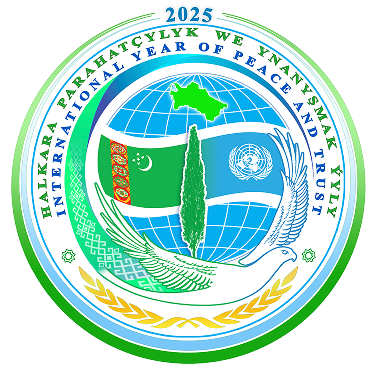THE STORY BEHIND THE FIRST-EVER KINDERGARTEN IN TURKMENISTAN: LITTLE ONES FROM KESHI

What was the first book published in Turkmenistan like? And why was it intended for children under school age? We have to take a look back in time to nearly 100 years ago to reply to these questions.
…In the summer of 1923, a family of teachers came to live in the settlement of Keshi. They rented a small house and began to get ready for the new school year. As there were plenty of small children in the area, the young teachers got an idea of organizing something like a study group to prepare the kids for school. The Ashgabat Public Education Department welcomed and supported the idea.
The Keshi Stud Farm allocated a three-room house with a big flower garden on its premises to the new kindergarten. The local education authority provided it with children’s furniture, utensils, tableware, and bed linen. The facility was all ready to welcome its first students. The only thing that remained to be done was to gain the trust and cooperation of the children’s parents. The task was very challenging as it was hard to predict how they would react to the proposal since caring for and nurturing children at home had been an age-old tradition.
After taking counsel together, the future kindergarten teachers walked along the streets of Keshi, stopping in front of the houses where they could hear kids’ cheery voices and knocking on the door. They were warmly invited to come in and were listened to carefully over a bowl of green tea. Parents wondered how their children could benefit from this yet unknown kindergarten, if they would be well fed and well cared for there, or if it would be a safe and enjoyable learning environment for them like the home setting. Mothers and fathers had scores of questions, seriously considering all the pros and cons of the innovative educational initiative. The guests, who showed genuine concern for the youngsters and explained the benefits of preparing them for school in a kind and friendly way, eventually inspired the parents’ respect and confidence. And they agreed to the proposal: eight boys and two girls came to the kindergarten the next morning.
The three- and four-year-olds were examining the room and toys with natural curiosity, looking at their teachers attentively as if asking the questions, “Well, what are we going to do here? What games will we play?”
This is the story behind the first kindergarten opened in Turkmenistan that was called experimental. The teachers had to handle challenging tasks while teaching their young students. Each child was unique and individual. Sometimes, the kid who came first put the toys in the lap of his/her robe, hiding the rest of the toys from the other kindergarteners by sitting on them. In order to make playing interesting for the children, the teachers brought them together on a big carpet with a pile of toy blocks, and they were building a ‘city’.
Although many things were entirely new to the little ones, they were able to easily and quickly adapt to various activities, a daily kindergarten routine, and doing tasks when on duty. The kids, who held plasticine in their hands for the first time, were making shapes out of it: the girls – dolls, and the boys – horses. They were good at it moving their little fingers with dexterity because their mothers had taught them to sculpt in clay when playing at home. The children immediately made their creations come to life: little plasticine figures “talked” to one another, while horses “galloped” on the table to the sounds imitating a clatter of hoofs. Hand modeling became their much-loved activity. Colored pencils brought absolute delight to the youngsters. Not only did they draw on sheets of paper but also on each other’s faces.
The little ones put their imagination into action in all their kindergarten activities: even sweeping the floor turned for them into play and much fun. The teachers developed their young students’ creative flairs, encouraged their enthusiasm and zest for life, and taught them the basics such as the alphabet and numbers through play. Working and communicating with the children gave real enjoyment and positive emotions to the adults themselves.
And still some of the parents had a cautious approach to the educational experiment at first. Some mothers came to the kindergarten, and spent much time sitting and watching their children involved in activities. Meanwhile, the youngsters learned the letters of the alphabet and numbers, soaked up the sun and played with a ball outdoors. After that they took an afternoon nap under the trees in the garden. Making sure that their children were properly fed and engaged in the interesting and useful activities, the young mothers returned home.
As time went by, the kids entered into school age. Now the seven-year-olds took their younger brothers and sisters to the kindergarten. The issue of running a toddler group came to the front. Soon afterwards, the group started working and was staffed with cooks, child care specialists and a nurse. The group boasted a well-equipped medical room to monitor the youngsters’ health status and provide proper care. When required, adults came there to seek medical attention, too.
The teaching strategies and techniques adopted in the experimental kindergarten were talked about not only in Ashgabat, but in other parts of the country. Preschool institutions were just in the making at that time, and the kindergarten teachers came up with the idea of writing a book about their students that could be helpful to young teachers just starting out on their careers. Published in Ashgabat in 1930, the book entitled ‘Those on Duty’ features poems about the “school for young children” (as the kindergarten was referred to) in Turkmen and Russian. It was authored by teacher Evgenia Stepanovna Dabech and her husband, artist Vladimir Aleksandrovich Gruzdev, who illustrated it. The illustrations in the book depict the first kindergarten students, and even many years later they could easily recognize themselves.
The book was translated by the then renowned writer Berdy Kerbabaev and emerging prose-writer Khaji Ismailov.
The boys and girls who attended the first kindergarten in Turkmenistan had different lives and their own destiny. They were given a good upbringing and proper pre-school education. Many of them became teachers, writers, and scientists. Talented artist Chary Amangeldyev is one of those kindergarteners.
Its former students who fought in the Great Patriotic War must be given special mention. Not all of them returned to their native settlement of Keshi alive. They gave their lives for a peaceful and happy childhood of future generations of children, their descendants, young citizens of Turkmenistan.


 NEWS
NEWS